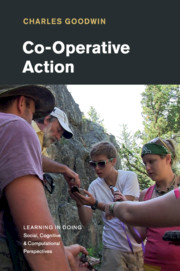Book contents
- Co-Operative Action
- Learning in Doing: Social, Cognitive and Computational Perspectives
- Co-Operative Action
- Copyright page
- Dedication
- Contents
- Figures
- Acknowledgments
- 1 What Is Co-Operative Action, and Why Is It Important?
- Part I Co-Operative Accumulative Action
- Part II Intertwined Semiosis
- Part III Embodied Interaction
- 12 Action and Co-Operative Embodiment in Girl’s Hopscotch
- 13 Practices of Color Classification
- 14 Highlighting and Mapping the World as Co-Operative Practice
- 15 Environmentally Coupled Gestures
- Part IV Co-Operative Action with Predecessors
- Part V Professional Vision, Transforming Sensory Experience into Types, and the Creation of Competent Inhabitants
- References Cited
- Index
- Series page
14 - Highlighting and Mapping the World as Co-Operative Practice
from Part III - Embodied Interaction
Published online by Cambridge University Press: 03 November 2017
- Co-Operative Action
- Learning in Doing: Social, Cognitive and Computational Perspectives
- Co-Operative Action
- Copyright page
- Dedication
- Contents
- Figures
- Acknowledgments
- 1 What Is Co-Operative Action, and Why Is It Important?
- Part I Co-Operative Accumulative Action
- Part II Intertwined Semiosis
- Part III Embodied Interaction
- 12 Action and Co-Operative Embodiment in Girl’s Hopscotch
- 13 Practices of Color Classification
- 14 Highlighting and Mapping the World as Co-Operative Practice
- 15 Environmentally Coupled Gestures
- Part IV Co-Operative Action with Predecessors
- Part V Professional Vision, Transforming Sensory Experience into Types, and the Creation of Competent Inhabitants
- References Cited
- Index
- Series page
Summary
Central to the work of scientists in many different fields is transforming the phenomena they are scrutinizing into what Latour and Woolgar (1979) call Inscriptions. While much analysis begins from inscriptions themselves, examining their progressive chaining and elaboration, here the focus is on the practices within a community required 1) to transform the world being examined into an initial inscription, here an archaeological map, and 2) to build new members able to see and operate on the world in the ways that make this possible. Highlighting practices, such as using a trowel to outline in the dirt itself the features to be mapped, create a figure clearly differentiated from what is literally the complicated ground in which it is embedded. Here the process of creating a first inscription, an archaeological map, is accomplished co-operatively by a senior archaeologist drawing the map and a new student charged with making measurements. The inability of the student to see the dirt in the way required to carry out her instructions publicly reveals gaps in her work-relevant perception. Co-operative action itself provides resources for remedying this, and creating the professional vision required to be an archaeologist.
* * *
- Type
- Chapter
- Information
- Co-Operative Action , pp. 212 - 220Publisher: Cambridge University PressPrint publication year: 2017

